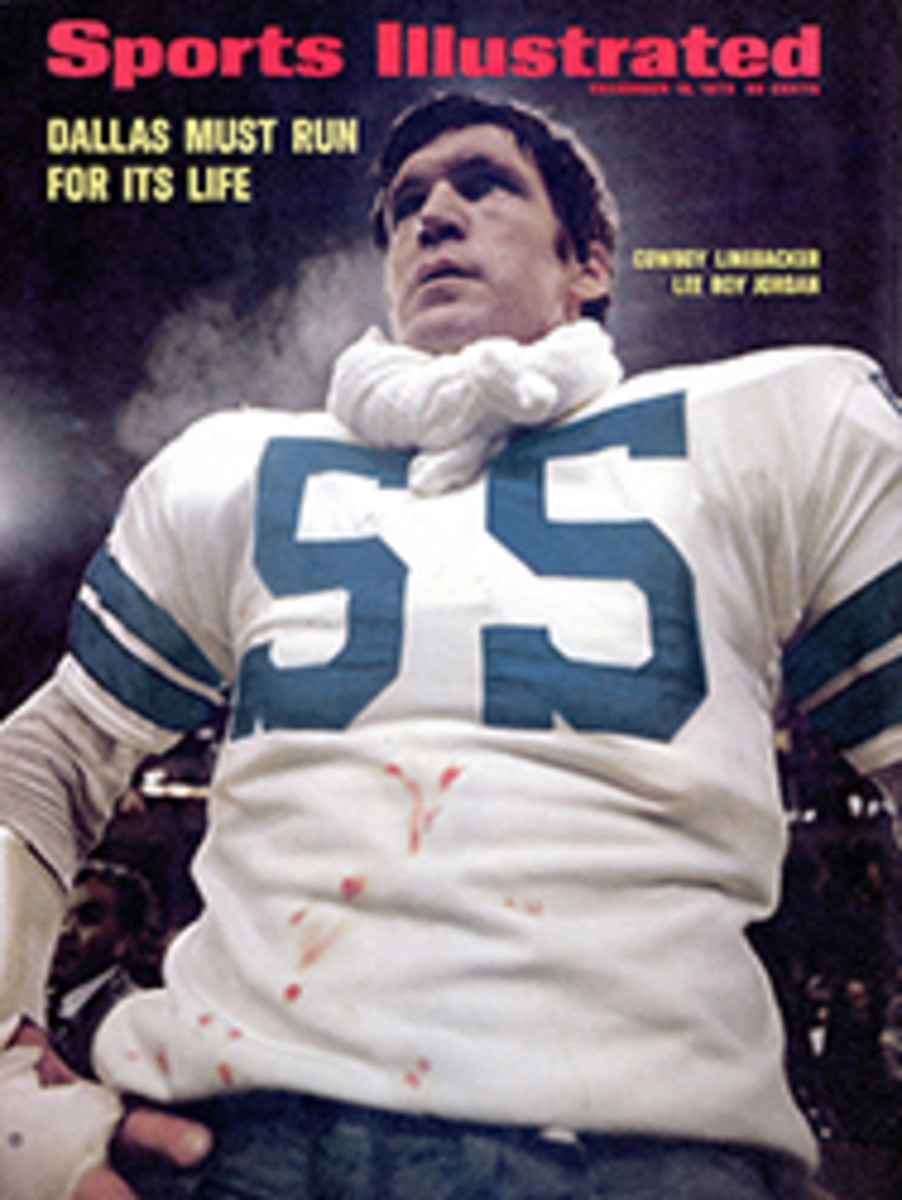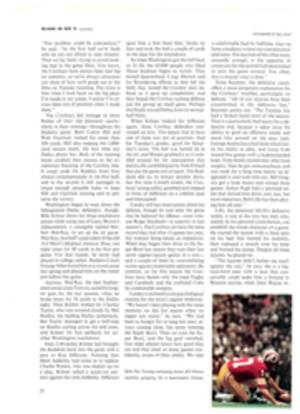
New world within one's compass
A man wearing dark glasses and boat sneakers came running out of the woods across a long open field, jogging through shoulder-high brown weeds, alone. He carried a crumpled map in one hand. In the other was a compass. It was near the gloaming of an autumn afternoon in New York state, and the man was perspiring awfully. His face was scratched, blood made a rill down one cheek. He was panting and wheezing and seemed a little popeyed behind his shades. And he ran through the weeds for the last 150 yards as fast as he could go and finally tottered beneath a banner marked FINISH. Then he sagged, but he smiled, he smiled.
A tiny crowd, not more than three dozen strong, was sitting on a small knoll. Two or three applauded politely. The man waved to his well-wishers and brushed some dried leaf bits from his shoulders and began to speak animatedly, though still panting, to anyone who would listen. Lost? Hell, yes, he had been lost. Here he was coming in two hours after everyone else, of course he was lost. But, look here—he rattled the map—wasn't this a mistaken marking here? Wasn't the boulder field actually beyond the stone fence and wasn't this stream supposed to be west of the control point—here?
No, someone said gently, patting the man's back. No, the map was right. The man in dark glasses was told that he had made some kind of mistake, probably gotten his compass bearing wrong or turned his map the wrong way or tried to find his way through the woods in dark glasses. He sighed, he frowned, but he did not complain further. In fact, he smiled. This was his first competition, wasn't it? He had finished. He had found his way to the FINISH. He was an orienteer now.
Undeniably, orienteering is an exquisite sport, an addictive sport, but it is strange. Perhaps the strangest thing of all about orienteering is that it is still so strange to so many Americans. After all, this is the age, is it not, of the rugged, suburban commuter-environmentalist, the citified nature lover, the deskbound fitness freak, the antispectator sportsman? This is the age, is it not, of at least an embryonic rebirth of retread frontiersmen: of hikers and backpackers and touring skiers, of Aquarian activists and outdoor aesthetes?
Well, orienteering is exactly the game for such times. It is a sport that actually injects intelligence and life into jogging, that most relentlessly mindless and boring of all leisure-time pursuits. Orienteering demands wit and stamina, sound logic and good lungs. It demands a lucid mind and a sure foot. It is played on vast acres of God's best tapestries, among great boulders and brown pine glades, beneath the melting gold of maple trees and over streaming fields of russet weeds, past crumbled stone walls and along cold, tumbling brooks.
It takes Vasco da Gama's appreciation of a damned fine compass and combines it with John James Audubon's love of nature. It takes Roger Bannister's adoration of the long-distance run and combines it with Marco Polo's love of a fine map. Orienteering combines fresh air with personal risk (though not much) and physical exertion with mathematics (though not much). It can be played by men, women, children. Also by old men, old women, old children.
All in all, orienteering offers an oddly exalted sense of achievement—even if you have lost, even if you have been lost out there.
In Scandinavia orienteering is a national sport, on the order of cricket in England or tennis in Australia. Orienteers are heroes. Champions are stopped on public streets and besieged for autographs. In Sweden there is a mammoth annual orienteering competition called the O-Ringen 5-Dagars. No fewer than 9,500 men, women and children turn out to compete in 25 classes. They eat and drink outdoors, slumber in sleeping bags and, when the competition starts, they plunge into the wilderness in their thousands, running like frightened reindeer, all clutching sweet map and dear compass. Russia, East Germany, Czechoslovakia, Switzerland and Bulgaria have scores of thousands of orienteers. There are, by conservative estimate, one million addicts in Europe today. And in Japan people can hop off their bullet trains at a number of stations and rind orienteering maps and routes with the stationmaster.
By contrast, an event labeled the Third United States Orienteering Championships was held the other day on Ward Pound Ridge Reservation in northeastern Westchester County, out in the best rolling, wooded section of New York City exurbia. About 150 people, no more, turned up. Quite a few of them, like the bemused, bespectacled fellow with the headband and the faulty map, didn't know what the sport was all about. They had simply read about it in a local paper. Most of the really serious classy orienteers, it turned out, were military men, members of the Marine Corps and Army—professional orienteers by any definition. A hard-muscled USMC captain named Roger Liesegang finished first, far ahead of the field. Trophies were presented, courtesy of Leatherneck magazine. The undeveloped state of orienteering in the U.S. is probably as well defined by the preponderance of military men at Pound Ridge as by any other factor. Before it became a thing of joy for civilians, it was a tactic of war. In the U.S. orienteering is still essentially a war game, though perhaps it will not be for long.
The sport of orienteering was invented in 1918 by Major Ernst Killander, a Swedish national youth leader who felt even then that perhaps the world was too much with spectator sports and not enough with participation. The good major organized a series of cross-country running events through Swedish forests, laying out points in the woods to be found with map and compass by the long-distance-running contestants. The game proved most appealing to Scandinavian penchants both for the love of endurance and for the rewards of logic.
The sport has changed almost not at all since Major Killander's day. It is—make no mistake about it—a race. The winner is the one who comes in quickest, with the least time elapsed in finding his way. But not all laurels go to the fastest long-distance runner. At the start of each competition (divided into categories to equalize the contestants by age and experience), each orienteer is given a contour map of the region (the more explicit the better) and a compass. Each runner starts alone, at intervals of a minute or two. A whistle blows, the contestant leaps forward to a board on which there is a master map marked with the controls (red and white flags) that must be located. Quickly—but accurately—he copies on his map the location of each control flag. There will be at least four, perhaps as many as 10 or 12, over a twisting, demanding course as long as five or six miles. Then with only his compass, his map and his wits for guidance, he sets out to find each control, in sequence. At each there will be a specially coded punch which he uses to mark a card he carries. This is to prove to the judges at FINISH that he did indeed find every control point laid out on the map.
A well-done orienteering course has its controls fairly well concealed, perhaps even hidden between boulders or up a tree. And in the so-called "elite" category, a contender must practically step on a bright little flag before he knows he has actually found it. The decisions involved in a hard-fought, top-class orienteering contest are innumerable.
A first-class orienteer must be able to scan a map, see the infinity of potential routes from one control to the next and analyze the terrain, the angles of approach and his own physical agility and stamina, as well as the apparent strength of the competition.
"Almost no one beats an American running from the last control to the finish," says a military man, "but we've never come close to winning a major European event. That's because we can't pick all the nuances off a map as fast as the Europeans can. Those guys take a glance and start running. We have to work it out for maybe a minute or more after every control. You're talking about seconds between the first 10 or 12 competitors in world-class meets."
In the U.S., the godfather of the sport is—or will be when the game finally catches on with the masses—Bjorn Kjellstrom, 62, a tall, handsome Swede who lives in Pound Ridge. N.Y. Not many years after orienteering was invented in Sweden, Kjellstrom and his brothers, Arvid and Alvar, became the nation's champions, in relays as well as individual competition. They went on orienteering barnstorming tours to the backwoods of Sweden, organizing weekend meets, taking on all comers and making a fairly good income. They used the money they earned from orienteering to perfect and manufacture a fine compass, Silva by name, which combines a rotating, liquid-based compass needle with a protractor. It is the orienteer's delight, particularly the amateur orienteer's delight, for it is a marvel of simplicity and precision. Today, 40 years and millions of Silva compasses later (the firm sells some 750,000 annually), Bjorn Kjellstrom is a wealthy man, an intelligent and influential force in world skiing (he is an executive vice-president of the Fédération Internationale de Ski) and, quite logically, a devoted supporter of the game of orienteering.
Kjellstrom has written the orienteers' bible, a handbook titled Be Expert with Map & Compass. It was Kjellstrom who coined the English word "orienteering" (in Swedish it is o-ringen), and his company owns the rights to the word.
"I do think orienteering has not caught on in the United States mostly because people have not heard much about it," he says hopefully. ""But I am sure it is a game Americans will learn to love. After all, the greatest feat of orienteering in the history of the world was done by Americans—landing a man on the moon."
Perhaps the fourth, fifth and sixth U.S. Orienteering Championships will be only a little more popular than was the third. But the chances are very good that ultimately there will be many, many more people like that scratched and sweating enthusiast in the shades and boat sneakers. For the fascinations and the satisfactions of orienteering—alien and esoteric as the game may sound now—are precisely the stuff of which the Age of Aquarius should be made.
ILLUSTRATION
HAVING FOUND ONE CHECKPOINT, AN ORIENTEER CHECKS HIS MAP AND HUSTLES ON

